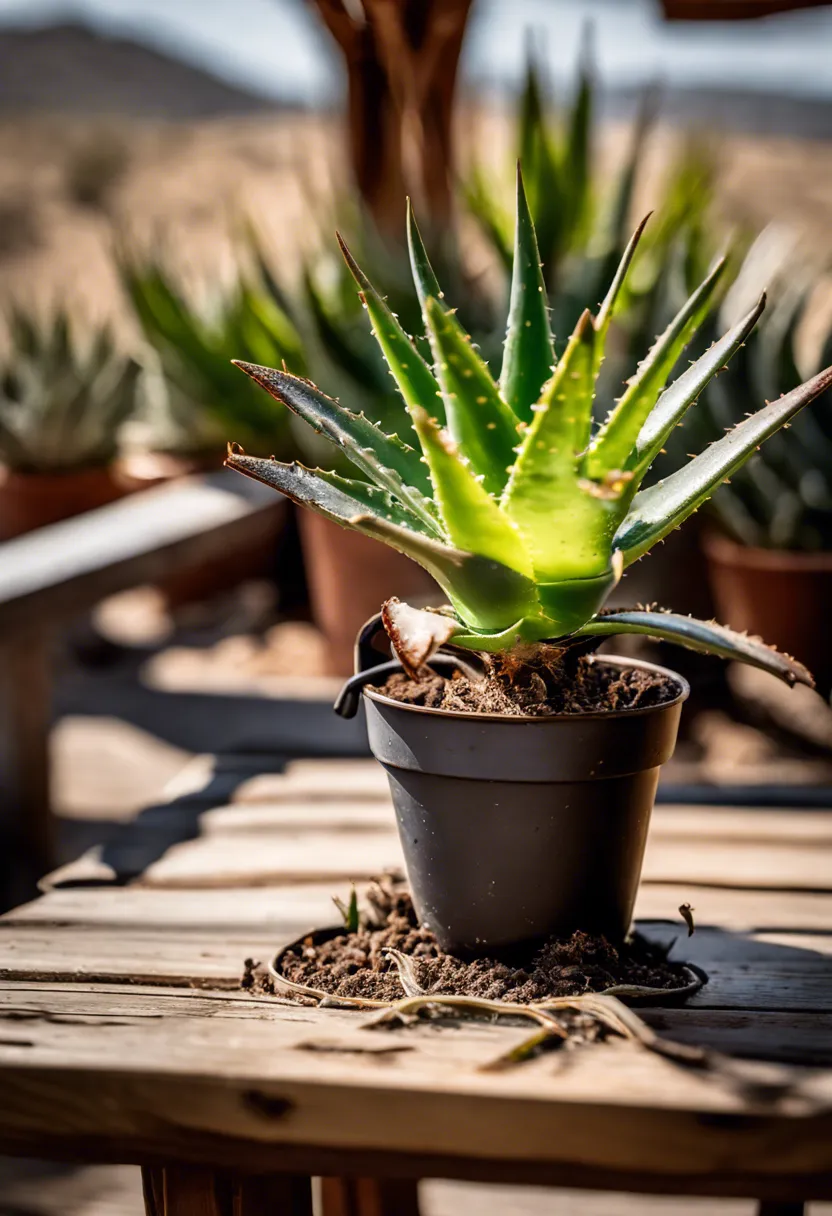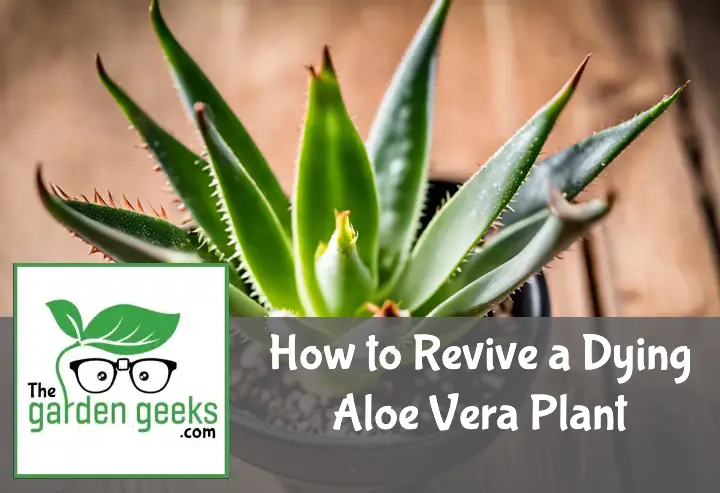Can you believe that 95% of indoor plants die due to improper care? One such plant is the resilient Aloe Vera. Even this hardy plant can suffer if not cared for appropriately. If you’ve ever wondered how to Revive a Dying Aloe Vera Plant, you’re in the right place.
In this blog post, we’ll demystify the process of bringing your Aloe Vera back from the brink. We’ll cover everything from identifying signs of distress to implementing life-saving measures.
So, buckle up and get ready for an entertaining journey into the world of plant revival. Keep reading about Revive a Dying Aloe Vera Plant!
Quick Answer
- Identify the signs of a dying Aloe Vera plant, such as discoloration, wilting, or slow growth.
- Understand the causes of decline like environmental stress factors, biological threats and common care mistakes.
- Revive your plant by following a step-by-step guide that includes adjusting light exposure, watering schedule, and possibly repotting.
- Prevent future issues by implementing measures like proper watering techniques, suitable pot selection and regular monitoring for pests or diseases.

Identifying the Signs of a Dying Aloe Vera Plant
Visual Symptoms and Their Meanings
Spotting a sad Aloe Vera isn’t rocket science. When your green buddy starts looking less perky, it’s time to play plant detective. First off, if your Aloe’s leaves are turning brown or yellow, it’s screaming for help. This discoloration is a big red flag. It usually means too much sun or not enough water. Think of it like the plant’s way of saying, “I’ve had too much sunbathing,” or “I’m super thirsty!”
Another clue? Wilting leaves. If your Aloe looks droopy, it could be drowning in water or craving more sunlight. Yes, plants get picky about their living conditions too! And let’s not forget spots or mushy sections on the leaves. These icky signs often point to overwatering or disease. Yikes!
Understanding these visual signs of dying plants is crucial. It’s like being a plant doctor. You see the symptoms and diagnose the problem. Remember, every leaf tells a story about your Aloe Vera plant health.
Other Indicators: Growth Patterns and Root Health
But wait, there’s more to an Aloe Vera SOS than just sad-looking leaves. Let’s talk growth patterns and roots – because yes, they matter big time! If your Aloe has stopped growing altogether or looks stunted, it’s not just being lazy. It could be shouting for better soil or more room to stretch its roots.
Speaking of roots, they’re like the hidden heroes of plant health. Healthy roots should be firm and white or slightly tan. But if you pull out your plant and find mushy, brown roots? That spells trouble with a capital T – we’re talking root rot here.
This sneaky issue often comes from overwatering but can also signal poor drainage in your pot. Either way, unhealthy roots mean an unhappy Aloe Vera.
So there you have it! Keeping an eye on both above-ground symptoms and below-the-soil secrets is key to diagnosing and fixing what ails your green friend. Remember, spotting these unhealthy growth patterns and assessing root health early can save your Aloe from becoming plant toast!
Causes of Aloe Vera Decline
A dying Aloe Vera plant can worry any plant lover. Let’s dive into why this happens.
Environmental Stress Factors
Aloe Vera plants love the sun but too much or too little can make them unhappy. Imagine wearing a coat in summer or shorts in winter. That’s how your Aloe feels with wrong light and temperature. Light requirements for Aloe Vera are pretty straightforward – they need bright, indirect sunlight. Too much direct sun can burn their leaves, while too little makes them weak.
Temperature is another tricky part. Aloes enjoy warm environments but don’t like extreme heat or cold. Think of them as Goldilocks; the condition has to be just right.
Lastly, water is essential but it’s easy to overdo it. These plants are desert natives, so they store water in their leaves. Overwatering is like giving them more food than they can eat, leading to root problems.
Biological Threats and Diseases
Not all threats to Aloes come from the environment; some are biological. Root rot is a biggie—it’s like your plant’s feet standing in wet socks all day long. Not pleasant, right? This happens when the soil doesn’t dry out between watering.
Fungal diseases also love moist conditions. They sneak up on your plant, causing spots on leaves or even worse damage if not caught early.
Pests are another headache for Aloe Vera plants. Tiny bugs like aphids and spider mites see your Aloe as a free meal ticket if you’re not careful.
Common Care Mistakes
Sometimes we love our plants a bit too much and end up harming them without realizing it. Overwatering is the number one mistake most people make with Aloes. Remember, they’re desert plants that thrive on neglect when it comes to water.
Incorrect potting can also spell trouble for these succulents. Using a pot without drainage holes or the wrong type of soil traps moisture around the roots, which is a big no-no for Aloes.
By avoiding these common pitfalls, you’re on your way to reviving your struggling Aloe Vera plant and keeping it healthy for years to come!



How to Revive Your Dying Aloe Vera Plant


Bringing your aloe vera back from the brink might seem like magic, but it’s all about giving it the TLC it really needs. If your plant looks more ‘desert disaster’ than ‘desert beauty’, don’t worry! We’ve got some simple steps that can help turn things around.
-
Check the pot and drainage: First things first, let’s play detective with the pot. If water sits at the bottom and dreams of being anywhere but there, you’ve got a problem. Aloe vera hates wet feet! Make sure your pot has holes at the bottom so water can say goodbye as soon as it’s done its job.
-
Consider repotting: If your plant is playing sardines in its current home, it’s time for an upgrade. Choose a pot slightly bigger than the current one and don’t forget rule number one: good drainage! Use a mix meant for succulents or cacti because they understand each other’s desert vibes.
-
Find the perfect spot: Aloe vera loves the sun but doesn’t want to bake in it all day. Think of a place that gets bright, indirect light. Too much direct sunlight can make its leaves go from green to brown quicker than you can say ‘aloe’.
-
Watering wisdom: Over-watering is like inviting trouble to a party nobody wanted to attend. Wait until the soil feels dry about an inch deep, then give it a drink. But remember, it’s better to under-water than over-water these desert dwellers.
-
Say no to cold: These plants are not fans of the cold. Keep them away from drafty windows in winter or any spot that gets too chilly for comfort. They prefer temperatures between 55-80°F (13-27°C).
-
Feed carefully: A little bit of food goes a long way with aloes. Feed them with a half-strength fertilizer made for succulents during their growing season in spring and summer only once every month or two.
-
Tackle pests gently: If you spot any unwelcome visitors like aphids or mealybugs, don’t panic! Gently wipe them off with a damp cloth or use an insecticidal soap that won’t hurt your plant.
By following these steps, you’re not just reviving your dying aloe vera; you’re setting up a spa retreat for it to thrive in!
Preventative Measures for Aloe Vera Health
Keeping your aloe vera plant happy and healthy is easier than you think. Just like us, they need the right environment to thrive. Let’s dive into some simple steps you can take to prevent your green buddy from feeling under the weather.
-
Water wisely: Aloe vera plants are like camels of the plant world; they store water in their leaves. So, they don’t need a drink as often as you might think. Overwatering is a no-no. Wait until the soil is completely dry before giving them a good soak.
-
Pick the perfect pot: Make sure your pot has drainage holes at the bottom. This helps any extra water escape instead of sitting in the pot, which could lead to root rot. Nobody wants that!
-
Let there be light: These plants love their sunshine but not too much direct sunlight, or they might get sunburned. Yes, plants can get sunburns too! A spot where they can bask in indirect sunlight is just perfect.
-
Avoid cold drafts: Aloe vera plants aren’t fans of the cold. Keep them away from drafty windows in winter or air conditioning vents in summer. They prefer temperatures between 55 and 80°F (13 and 27°C).
-
Feed them right: While aloe veras aren’t big eaters, they do appreciate a little snack now and then. Use a half-strength fertilizer made for houseplants once in the spring and maybe again in late summer.
By following these simple steps, you’ll keep your aloe vera plant healthy and prevent many common issues that could make it unhappy. Remember, a little care goes a long way!
To Wrap Up
So, you’ve learned a lot about how to Revive a Dying Aloe Vera Plant, huh? Remember, it’s all about the right balance of water, light and love.
Don’t forget to check on your plant often. If it’s looking sick, make sure it’s not too wet or too dry. And give it plenty of bright light – but not direct sun!
In the end, don’t be hard on yourself if things don’t work out. Plants are tricky! But with patience and care, you can help your aloe thrive again.


FAQs about ‘How to Revive a Dying Aloe Vera Plant’.
How long does it take to revive a dying Aloe Vera plant?
The time required to revive a dying Aloe Vera plant can vary depending on the severity of its condition. Generally, with proper care and attention, you may see improvements within 2-4 weeks.
Can an Aloe Vera plant recover from overwatering?
Yes, an Aloe Vera plant can recover from overwatering. The key is to let the soil dry out completely before watering again and ensure proper drainage to prevent waterlogging.
How often should I water my Aloe Vera plant?
A good rule of thumb is to water your Aloe Vera plant once every two weeks. However, this can change based on the climate and season. Always check the soil’s moisture level before watering.
Why are the leaves of my Aloe Vera plant turning yellow?
Yellow leaves in an Aloe Vera plant could be due to overwatering or lack of nutrients. Check your watering routine and consider using a well-balanced fertilizer for indoor plants.
Can I use any type of soil for my Aloe Vera plant?
No, it’s best to use a well-draining cactus or succulent mix for your Aloe Vera plant. These soils allow excess water to escape preventing root rot.
What type of light is best for an Aloe Vera plant?
A bright, indirect light source is ideal for an Aloe vera plant. Too much direct sunlight can cause leaf burn while too little light can lead to weak growth and pale leaves.


